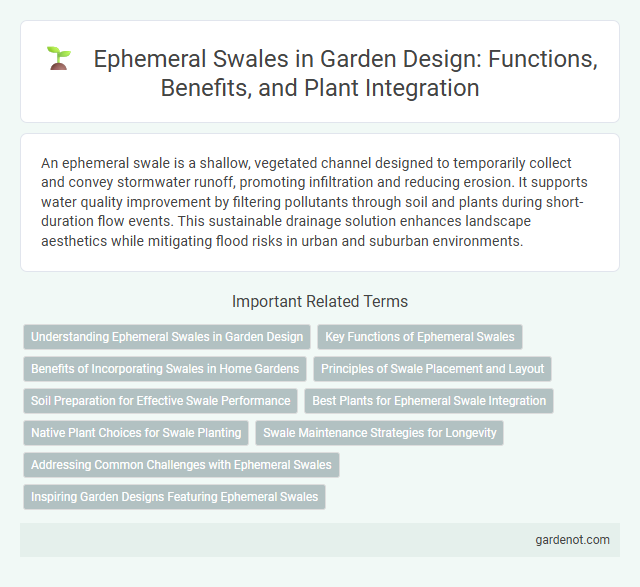An ephemeral swale is a shallow, vegetated channel designed to temporarily collect and convey stormwater runoff, promoting infiltration and reducing erosion. It supports water quality improvement by filtering pollutants through soil and plants during short-duration flow events. This sustainable drainage solution enhances landscape aesthetics while mitigating flood risks in urban and suburban environments.
Understanding Ephemeral Swales in Garden Design
Ephemeral swales are shallow, temporary channels designed to capture and direct stormwater runoff in garden landscapes, promoting efficient water absorption and reducing soil erosion. These swales typically remain dry between rainfall events, supporting native vegetation adapted to alternating wet and dry conditions, which enhances biodiversity and soil health. Incorporating ephemeral swales in garden design optimizes water management by mimicking natural hydrological processes and improving landscape resilience to heavy precipitation.
Key Functions of Ephemeral Swales
Ephemeral swales play a crucial role in stormwater management by temporarily capturing and conveying runoff during and immediately after rainfall events. Their key functions include promoting infiltration to recharge groundwater, filtering pollutants through vegetation and soil media, and reducing peak flow rates to prevent downstream flooding. These features enhance water quality and support sustainable urban drainage systems by mimicking natural hydrological processes.
Benefits of Incorporating Swales in Home Gardens
Ephemeral swales enhance home gardens by efficiently managing stormwater runoff, reducing soil erosion, and promoting groundwater recharge. These shallow, vegetated channels capture and slowly infiltrate rainwater, supporting plant health and increasing garden resilience during dry periods. Incorporating ephemeral swales creates sustainable landscapes that improve water quality and reduce the need for irrigation.
Principles of Swale Placement and Layout
Ephemeral swales are designed to manage stormwater runoff by temporarily holding and infiltrating water during rainfall events. Optimal placement relies on natural topography, ensuring swales follow the contour lines to maximize water retention and prevent erosion. Proper layout includes sizing swales based on watershed area and soil permeability to enhance infiltration and support groundwater recharge effectively.
Soil Preparation for Effective Swale Performance
Ephemeral swales require well-prepared soil to maximize infiltration and prevent erosion, emphasizing loose, well-graded soil with high organic matter content for optimal water absorption. Proper soil preparation involves deep tilling and incorporation of compost or mulch to enhance soil structure and nutrient availability. Ensuring soil permeability and stability supports the swale's capacity to temporarily hold runoff while promoting groundwater recharge.
Best Plants for Ephemeral Swale Integration
Best plants for ephemeral swale integration include native grasses like little bluestem and switchgrass, which tolerate fluctuating moisture conditions and stabilize soil. Fast-growing sedges such as Carex bicknellii promote water infiltration while providing habitat for pollinators. Incorporating flood-tolerant wildflowers like blue flag iris enhances both the ecological function and aesthetic value of ephemeral swales.
Native Plant Choices for Swale Planting
Ephemeral swales benefit from native plant choices such as Carex spp., Juncus effusus, and Asclepias incarnata, which are adapted to intermittent wet-dry cycles and enhance stormwater infiltration. These species improve soil stabilization, support local biodiversity, and require minimal maintenance due to their resilience to seasonal fluctuations. Incorporating native grasses and wildflowers also promotes pollinator habitats and natural nutrient cycling within ephemeral swale ecosystems.
Swale Maintenance Strategies for Longevity
Ephemeral swales require regular inspection to remove sediment buildup and prevent clogging, which maintains optimal water flow and infiltration capacity. Vegetation management, including periodic mowing and replanting native species, enhances soil stability and maximizes pollutant filtration. Implementing these maintenance strategies extends the functional lifespan of ephemeral swales and ensures sustainable stormwater management.
Addressing Common Challenges with Ephemeral Swales
Ephemeral swales effectively manage stormwater runoff by temporarily capturing and infiltrating excess water during heavy rainfall events, reducing flood risks in urban areas. These swales address common challenges such as soil erosion and sediment buildup through engineered vegetation and soil media that promote filtration and slow water flow. Proper maintenance and design optimization enhance their performance, preventing clogging and ensuring consistent water quality improvement in stormwater management systems.
Inspiring Garden Designs Featuring Ephemeral Swales
Ephemeral swales enhance garden designs by capturing and directing rainwater efficiently, promoting sustainable water management and reducing soil erosion. These shallow, seasonal channels support native plant growth by mimicking natural hydrological patterns, creating dynamic, thriving landscapes. Incorporating ephemeral swales inspires eco-friendly garden aesthetics while improving biodiversity and resilience in urban and residential settings.
Ephemeral swale Infographic

 gardenot.com
gardenot.com